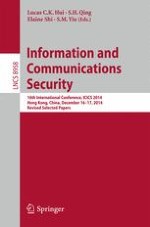2015 | Buch
Information and Communications Security
16th International Conference, ICICS 2014, Hong Kong, China, December 16-17, 2014, Revised Selected Papers
herausgegeben von: Lucas C. K. Hui, S. H. Qing, Elaine Shi, S. M. Yiu
Verlag: Springer International Publishing
Buchreihe : Lecture Notes in Computer Science
